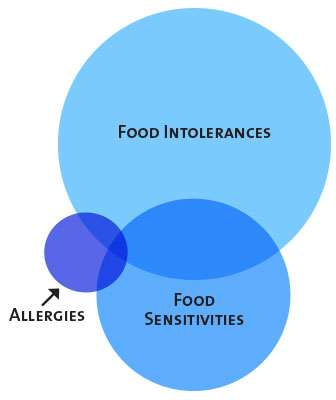Justin, age 11, suddenly developed asthma “out of nowhere.” His mom, a health care professional, did not want to follow the traditional treatment of steroids inhalers due to their long-term side effects; her opinion was confirmed by warnings that indicated increased agitation, bone and joint tissue issues, and dependency problems with the on/off cycle of use. She wanted a more natural approach instead – one that would get to what caused his asthma in the first place.
Eight-year-old Emily had multiple food sensitivities. She couldn’t drink milk, or eat wheat and bananas. Her most severe allergy was to latex – using a Band-Aid from the school nurse’s office would turn into an itchy, full-body rash, and her throat would swell, making it difficult to breathe. Emily’s parents did not want her to live in fear of her next episode, nor did they want her to be on drugs or have to endure shots. Thinking there must be an alternative way to approach this problem, they began their search.
Since infancy, Brooke had allergy-like reactions to many common substances, including milk, chocolate and eggs … ingredients found in many of her favorite treats. It was hard for Brooke, now age 9, to enjoy anyone’s birthday celebrations, especially her own, because she could not have cake and ice cream. While her symptoms were more “lifestyle” than life threatening, her mom decided to look for a way to eliminate her food sensitivities.
What do these children have in common? All developed complications from food sensitivities. What do these parents have in common? The desire to end their children’s suffering without any side effects except relief.
According to a study released in 2013 by the Centers for Disease Control and Prevention, food allergies among children increased approximately 50% between 1997 and 2011.
While alarming, this statistic doesn’t include two more common types of food reactions: food sensitivities and food intolerances. These are a far greater problem, though they take a back seat to food allergies in mainstream medicine because they are not considered “life threatening.”
 The three major types of food reactions are:
The three major types of food reactions are:
“True” food allergy: A severe reaction to a food agent involving the elevation of specific antibodies (IgE) due to eating it.
Sensitivity: An adverse reaction in the body upon exposure to a food agent.
Intolerance: The absence of a particular chemical or physiological process needed to digest one, or a combination of, the three major food groups: fats, proteins and/or carbohydrates.
While all types of food reactions are caused by an overreaction of one’s immune system, a crucial difference is reaction time. A food allergy reaction is immediate (for example, anaphylactic shock from a peanut allergy), whereas the reaction time for a food sensitivity or intolerance may not appear for hours or even days after the child has eaten the offending food(s).
Fortunately, more children fall into the category of having a food sensitivity or food intolerance than a true life-threatening allergy. Maybe you have taken your child in for allergy testing, and nothing shows up or only a few items show up. Yet you know that your child is reacting to a lot more foods. Why? Because your child may be experiencing a food sensitivity or intolerance instead of a true allergy.
While the only remedy for a child who is truly allergic is avoidance, there are treatments that can help reduce or eliminate food sensitivities and intolerances. That’s good news for parents because it means your child does not have to take medications or be given shots that only provide temporary relief from symptoms. It may also mean your child doesn’t have to suffer from associated problems of unsightly rashes, forgotten inhalers, missed school, or lack of energy.
As for Justin, his mother is delighted that he is “back to his old self again,” off of steroids, and no longer missing school. Emily’s mother is no longer afraid of getting a call from the school nurse, and Emily is thrilled because she can eat bananas and wear Band-aids without impunity. And in the words of Brooke’s mom, “she can eat like a normal child now” … both girls can attend birthdays and other celebrations with delight instead of trepidation.
If traditional allergy testing, shots, medications or DIY treatments have not worked for your child, there are effective alternatives available. Search for a professional who uses a functional and neurological approach to identifying and desensitizing the body’s reaction to the food substance so that the immune system no longer sees it as a foreign invader. Just like Justin, Emily and Brooke, your child can discover the joy of eating some of his or her favorite foods again.
[sws_blue_box box_size=”580″]
Symptoms of Food Reactions
Some kids may hurt all the time and not know they hurt, or may just accept their symptoms as their “normal.” Skin problems, dark circles under the eyes, and the contents of the toilet bowl all offer valuable information about what’s not being digested. Common symptoms of food reactions in children include rashes, asthma, bowel and stomach problems, inattention or difficulty focusing in school, sleep problems, pimples, “brain fog,” irritability, headaches, lethargy/lack of motivation, and congestion. [/sws_blue_box]

Brooke loved coming to Dr. Patrick’s office and would draw pictures to show her gratitude for his help with overcoming her food sensitivities. This is the chocolate cake Brooke was able to eat for the first time on her 7th birthday!
For More Information
- Digestion Relief Center: Chico based business offers a comprehensive list of published articles online, and free monthly North State seminars about food-related sensitivities, allergies, intolerances and digestion-related problems. http://www.DigestionReliefCenter.com; (530) 899-8741.
- Food Allergy Research & Education (FARE): National organization offering comprehensive resources regarding allergies. Visit http://www.foodallergy.org.
- Book: The Whole Way to Allergy Relief & Prevention: A Doctor’s Guide to Treatment & Self Care, by Jacqueline Krohn, MD, and Frances Taylor, MA. See http://www.ktbooks.net.
Posted in: Health & Nutrition
Comment Policy: All viewpoints are welcome, but comments should remain relevant. Personal attacks, profanity, and aggressive behavior are not allowed. No spam, advertising, or promoting of products/services. Please, only use your real name and limit the amount of links submitted in your comment.
You Might Also Like...

3 Tips To Help Kids Face Their Fears
It’s normal for children to have fears. Kids may have bad dreams, be frightened of the dark, or find a movie scene scary. However, kids can develop fears that interrupt […]

Pediatrician Q&A with Dr. Zeke (Ezekiel Melquist, MD)
Q: As back-to-school time approaches, many parents dread the first month or so, as many kids get sick in those first few weeks. Why does that happen? A: Each child has […]

The Troubled Tummy: Deciphering Your Child’s Chronic Digestive Distress
The dinner scene is dishearteningly familiar. Your 8-year-old daughter takes a couple bites of spaghetti, then starts poking at the food on her plate. “Eat up!” you say brightly, hoping […]

Road Trippin’ – Healthy, Kid-Friendly Snacks for the Road
Parents know that a hungry kid equals a cranky kid, and let’s not forget that parents get hungry and cranky, too! Nothing like a car full of “hangry” road trippers […]





